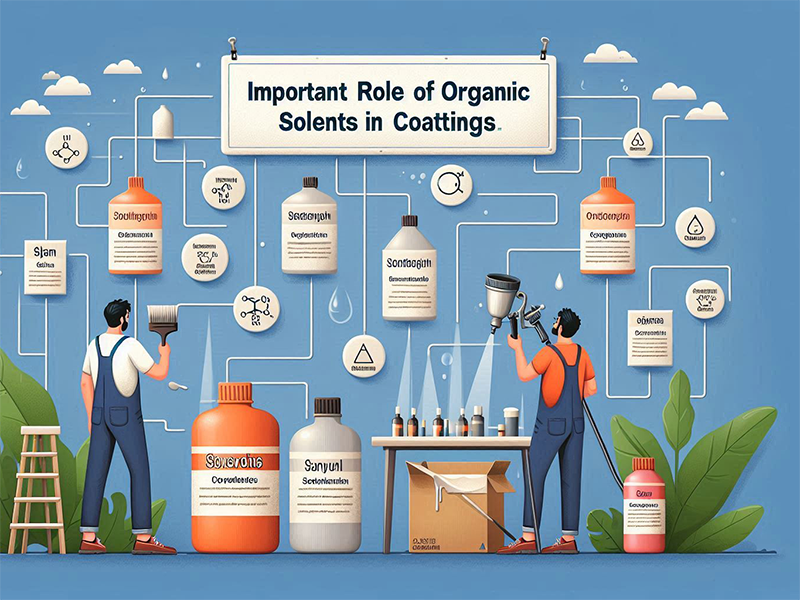In mundo vestitur; organicum menstrua pernecessariae sunt "indictum heroum". Non solum adiuvant resinas dissolvere, sed etiam viscositatem vestium moderari, proprietates fluxus emendare, ac denique formationem pellicularum promovere. Hodie intromittamus quomodo haec menstrua, per interationes physicas et chemicas, systemata efficiant aptiores ad applicationem et vim finalem efficiendi efficiendi.
Resins dissolvendo: Providendo Liquid Systema Uniform
principle
Cum polaritas solutarum par resinae, moleculae solvendas inter moleculas resinae penetrant, copias intermoleculares dissipant ut vincula hydrogenii, copiae van der Waals, vel interactiones dipole, resinae ita dissolventes.
Exempli gratia, keton solventes (ut methyl ethyl ketone, MEK) efficaciter possunt dissolvere resinas polyurethanas propter simili polaritatem.
influentia factores
Solventes Polaritas: Solventes Polares (qualis alcohols, ketones, esters) ad dissolvendas resinas polares (ut resinas alkyd et polyurethanes), solventes non polares (ut toluene et xylene) meliores sunt resins polaris (ut resina acrylica).
Parametri Solubilitas solvens: Solventa cum similibus Hildebrandi parametri solubilitatem cum resinis magis compatiuntur.
examples
Acrylicas fucis → Usus esters (eg, butyl acetas) et hydrocarbonum aromaticum (eg, xylene) ad dissolutionem.
Polyurethane coatingis → Utere ketonibus (eg, MEK, MIBK) ad dissolutionem.
Alkyd Resin Coatings → Alcoholis utere (eg, isopropanol) et ketonibus (eg, acetonis).
Adjusting viscositas: Optimizing Application euismod
principle
Solventes interationes inter resinam et fillers minuunt, vires intermoleculares intra systema coating demittentes, viscositatem decrescentes et proprietates fluunt meliores. Per spargit, moderata viscositas coatings superficies aequalius operire potest, applicationem qualitatis amplificans.
influentia factores
Princeps Volatilitas Solventa (eg, acetone, MEK) viscositatem celeriter minuunt et ad tunicas celeriter siccandas aptae sunt.
Humilis LEVITAS Solventa (exempli gratia xylene, butyl acetas) fluiditatem coating tenent ac ideales applicationum penicilli vel cylindri sunt.
examples
Automotiva (Spraying) → Viscositas humilis require; eligere volatilia ketones (eg, MEK).
Lignum Coatings (Brushing) → Elige esters tardius-evalescentes (exempli gratia, butyl acetas).
Improving O Properties: Preoccupo Peniculus Marks et Aureum Peel
principle
Quantitas solvendi congruam intentionem superficiei minuit, sinit litura aequabiliter dilatare et notas penicillo extenuando deflectere, vel "cortices orange" effectus. Per conpensationem solventes altam et humilem volatilitatem, evaporatio solvendo uniformis conservari potest, quaestiones impediens ut superficies nimis cito siccatur dum interior manet humida (retentio solvenda).
influentia factores
Rate solvendo Evaporatio:
Nimis Fast → Sit causa bullae, habens, vel cortices.
Tardius → Ad deflectens applicationis difficultates.
Solvendo Mixtio Ratio: Typice, coniunctio ieiunii, medium-, et tardi evanescentes menstrua ad optimize adaequationem efficiens adhibetur.
examples
Metallica Paints (Spraying) → Requirere bonum adaequationis; utere lento solvendo evanescente (exempli gratia, butyl acetate) ad vitandum cortices aurantios.
Industriae Anti-Corrosion Coatings → Requirere velox remittit; utere menstrua ieiunii evanescente (exempli gratia acetone, MEK).
Promotio film institutionis: Evaporatio Uniform ad lenis coating
principle
Post applicationem, menstrua paulatim evanescunt, resinae moleculae permittentes propius accedunt et implicant, tandem cinematographicum continuam et aequabilem efformantes. Rate bene libratum evaporationem solvendo moderatur processum formationis cinematographici, defectibus vitandis ut pinholes, cortices aurantios, et bullas.
influentia factores
Evaporatio Rate: Nimis celeriter superficies coating exsiccare potest coram interiore, potentia ducens ad rimas vel habensque.
Compatibilitas solvens: variae coniunctiones solvendo aequalitatem movendi afficiunt. Exempli gratia, appositionem debitam solvendi quantitatem humilem LEVITAS impedire potest ne nimis celeri siccatio.
examples
PU Wood Coatings → Requirere tardius ketones + esteros (exempli gratia MIBK + butyl acetas) ut formationem cinematographicam uniformem curet.
Nitrocellulosum RAMULUS Pigmenta → Require celeriter ketones evanescentes (exempli, MEK) ad minuendum tempus siccitatis.
Conclusio
Munus menstruarum organicarum in coatingiis superat meram "dissolutionem". Viscositatem accommodantes, proprietates fluunt meliores, ac formationem cinematographicam promoventes, directe afficiunt applicationis observantiam et qualitatem finalem coatingarum. Diligens ius solvens mixtio non solum faciliorem efficit coatings adhibere, sed etiam augere vetustatem ac finem.
Proximo tempore parietem aut superficiem aspergine pingis, sume momentum ad cognoscendas hos liquores ordinarios, qui silentio operantes post scaenas mirabilia!
pro magis informationes nostras visitare website at


 EN
EN
 AR
AR
 BG
BG
 HR
HR
 CS
CS
 DA
DA
 NL
NL
 FI
FI
 FR
FR
 DE
DE
 EL
EL
 HI
HI
 IT
IT
 JA
JA
 KO
KO
 NON
NON
 PL
PL
 PT
PT
 RO
RO
 RU
RU
 ES
ES
 SV
SV
 TL
TL
 IW
IW
 ID
ID
 LV
LV
 LT
LT
 SR
SR
 SK
SK
 VI
VI
 HU
HU
 TH
TH
 TR
TR
 GA
GA
 CY
CY
 KA
KA
 LA
LA
 MN
MN
 KK
KK
 LB
LB




